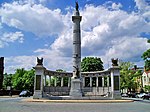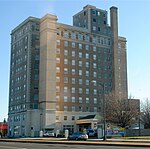Stonewall Jackson Monument

The Stonewall Jackson Monument in Richmond, Virginia, was erected in honor of Thomas Jonathon "Stonewall" Jackson, a Confederate general. The monument was located at the centre of the crossing of Monument Avenue and North Arthur Ashe Boulevard, in Richmond, Virginia. The bronze equestrian statue was unveiled in 1919. Along this avenue are other statues including Robert E. Lee, J. E. B. Stewart, Jefferson Davis, Matthew Maury and more recently Arthur Ashe. Thomas Jackson is best known as one of Robert E. Lee's most trusted commanders throughout the early period of the American Civil War between Southern Confederate states and Northern Union states. He rose to prominence after his vital role in the Confederate victory at the First Battle of Bull Run in July 1861, continuing to command troops until his untimely death on May 10, 1863, after falling fatally ill following the amputation of his wounded arm.Several memorials were commissioned in his honor including the statue in Richmond, with perhaps the most well-known the Confederate Memorial Carving at Stone Mountain, commemorating Thomas Jackson, Robert E. Lee and Jefferson Davis. In Southern states, generals were often revered with statues erected for notable Confederate men at times satisfying a need of the Confederate states to extract virtues from past "heroes" and self-identify with them for the future, perpetuating the Lost Cause mythology. Many of these statues, including the Jackson monument in Richmond, have recently come into controversy in the aftermath of the murder of George Floyd and the renewed attention to Black Lives Matter (BLM) Movement that seeks to more accurately represent history and the racial inequalities black people continue to endure. Jackson's statue along with several others commemorating generals were either torn down by protesters supporting BLM or were removed on the mayor's orders during June and July 2020.
Excerpt from the Wikipedia article Stonewall Jackson Monument (License: CC BY-SA 3.0, Authors, Images).Stonewall Jackson Monument
North Arthur Ashe Boulevard, Richmond Scott's Addition
Geographical coordinates (GPS) Address Nearby Places Show on map
Geographical coordinates (GPS)
| Latitude | Longitude |
|---|---|
| N 37.56063 ° | E -77.47111 ° |
Address
North Arthur Ashe Boulevard 705
23220 Richmond, Scott's Addition
Virginia, United States
Open on Google Maps








